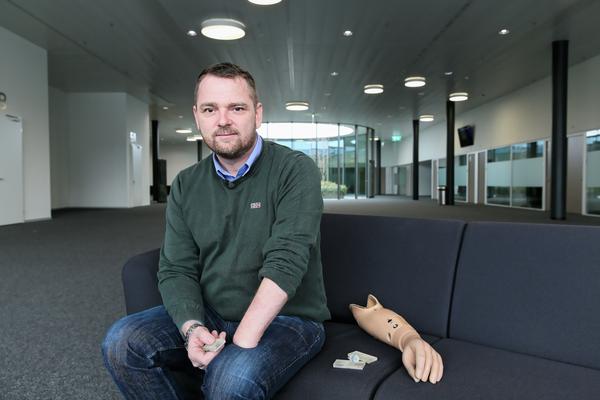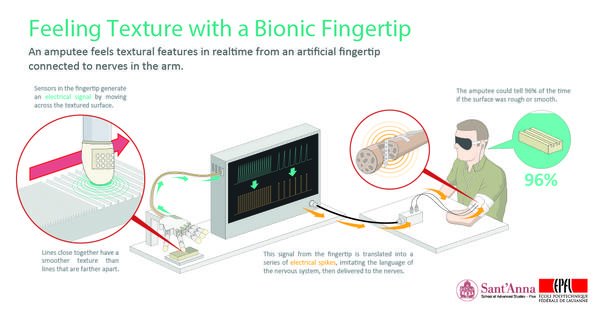The technology to deliver this sophisticated tactile information was developed by Silvestro Micera and his team at EPFL (Ecole polytechnique fédérale de Lausanne) and SSSA (Scuola Superiore Sant’Anna) together with Calogero Oddo and his team at SSSA. The results, published today in eLife, provide new and accelerated avenues for developing bionic prostheses, enhanced with sensory feedback.

«The stimulation felt almost like what I would feel with my hand," says amputee Dennis Aabo Sørensen about the artificial fingertip connected to his stump. He continues, «I still feel my missing hand, it is always clenched in a fist. I felt the texture sensations at the tip of the index finger of my phantom hand.»
Sørensen is the first person in the world to recognize texture using a bionic fingertip connected to electrodes that were surgically implanted above his stump.
Nerves in Sørensen’s arm were wired to an artificial fingertip equipped with sensors. A machine controlled the movement of the fingertip over different pieces of plastic engraved with different patterns, smooth or rough. As the fingertip moved across the textured plastic, the sensors generated an electrical signal. This signal was translated into a series of electrical spikes, imitating the language of the nervous system, then delivered to the nerves.
Sørensen could distinguish between rough and smooth surfaces 96% of the time.

In a previous study, Sorensen’s implants were connected to a
Simulating touch in non-amputees
This same experiment testing coarseness was performed on
But does this information about touch from the bionic fingertip really resemble the feeling of touch from a real finger? The scientists tested this by comparing
The research demonstrates that the needles relay the information about texture in much the same way as the implanted electrodes, giving scientists new protocols to accelerate for improving touch resolution in prosthetics.
«This study merges fundamental sciences and applied engineering: it provides additional evidence that research in neuroprosthetics can contribute to the neuroscience debate, specifically about the neuronal mechanisms of the human sense of touch," says Calogero Oddo of the BioRobotics Institute of SSSA. «It will also be translated to other applications such as artificial touch in robotics for surgery, rescue, and manufacturing.»
The research was carried out by EPFL and SSSA in collaboration with Università di Pisa, IRCCS San Raffaele Pisana, Università Cattolica del Sacro Cuore, Università Campus Biomedico.
This work was partly supported by EU Grants TIME, NEBIAS and NANOBIOTOUCH, by the Italian grants NEMESIS (funded by the Italian Ministry of Health), PRIN/HandBot (funded by the Italian Ministry of Research), and PPR2 (funded by the National Institute for Insurance against Industrial Injuries), by the ENABLE project funded by the Wyss Center for Bio and Neuroengineering, and by the Swiss National Competence Center in Research in Robotics.
Source: http://actu.epfl.ch/news/amputee-feels-texture-with-a-bionic-fingertip/


